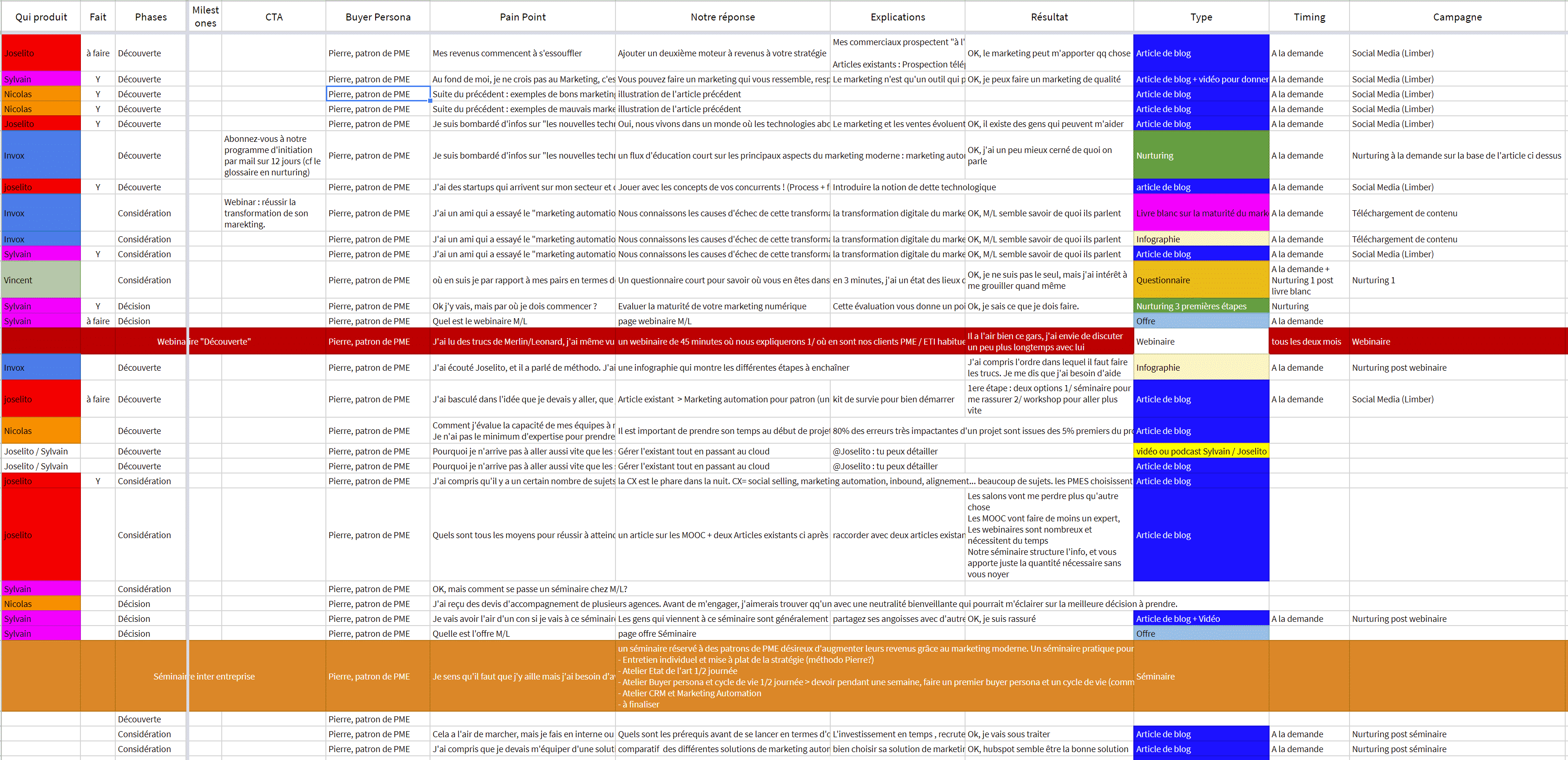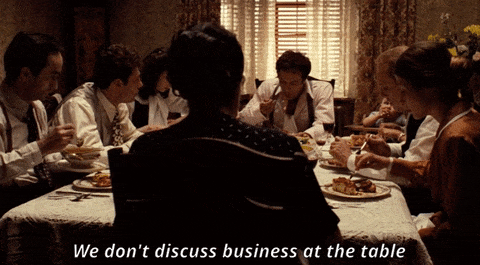The maturity of B2B digital marketing continued… As a reminder, here is the first article in the series, Preparing for the trip.
- Preparing for the change
- The first 3 months and the content strategy (here you are)
- Starting your marketing automation
- Moving towards “demand generation
- Conversational marketing (in progress)
- Conversational marketing (in progress)
- Revenue performance management (in progress)
After reading the previous article, you decided to launch your content strategy and chose a marketing automation solution. If you have followed my recommendations, you have :
- taken stock of your current marketing: what works and what doesn’t,
- defined a three-year budget and involved your management committee,
- defined success indicators for your project and your marketing, which you shared with your management.
- cleaned up and enriched your data before launching the marketing automation project.
That’s a great start! Let’s move on!
I might as well tell you right now, in real life, I’ve never met a company that starts with the content strategy. I’ll come back to this later, but in the meantime, to avoid losing you in my article, I’ve prepared a little summary for you. What a luxury.
- In real life: I reassure myself by buying my equipment first
- Digital transformation: the content strategy
- What is a “content strategy” ?
- Imagine the ideal journey with your buyer persona or why Mario belongs in marketing
- Making the right decisions with the content matrix
- How to start your content strategy ?
- How to coordinate content strategy and marketing automation ?
- The cost of a content strategy
- A word about the website
- Choose your marketing automation solutionmarketing automation
- To conclude on the content strategy
In real life: I reassure myself by buying my equipment first
If you have read the previous article and the “tragi-comedy of digital transformation“, you have understood. Logic would dictate that you start by :
- plan your journey a little,
- get to know your customers well, and define the way you’re going to talk to them, and the stories you’re going to tell them (stories in the sense of a narrative that interests your audience, not mumbo-jumbo – yes, I’m from the north, mi!),
- anticipate organisational changes,
- change management, which will enable a change in the way marketing and sales work, and even customer service, communication and IT.
But in large accounts, it NEVER happens like that (it seems that in SMEs, it’s the same, my partner Josélito tells me).
The company decides to change…
I tell you the classic scenario, experienced dozens of times. A “trigger” causes an urgent need for change:
- The arrival of a new boss or marketing director
- A customer who is particularly unhappy with his or her customer experience and makes it known,
- A changing regulation that the company is unable to comply with with current technology (e.g. the RGPD regulation)
And suddenly, it’s an emergency, you have to show that you are changing, that things are happening, management demands progress reports…
Management has been convinced by the editors, who have done their job well, that technology is a very good way to show change. Why is that?
Because it’s easy to buy a software solution, a project, support. It doesn’t involve – at first sight – working on the human.
In fact, working on people is a pain! No one wants to change their habits, nor do they want to do extra work. Everyone is stressed about their job.
I’m coming to the sales…
If a marketing person comes to sales and explains :
- that this will change soon,
- that they’ll be getting fewer but better qualified sales leads,
- with all the customer journey information needed to continue the conversation,
At best, a cautious smile greets the marketing person, or else :

“It’s just another marketing gimmick that doesn’t do anything. I don’t understand why we continue to tolerate them, after all, we are the ones who run the shop…”
Hi com’!
In the communication department, I explain :
- that we will have to bring our ways of working closer together,
- that our communication must be aligned between institutional communication and communication throughout the customer journey,
- that we have the same targets, and that we should have a clear and shared vision of the difficulties of our “buyer personas”,
- that in the long term, the teams must work together.

Again, a feeling of incomprehension, blank stares… And suddenly,
“You want to take our job, don’t you?
– No, not at all! But it would be better if we coordinated our words, otherwise it would be a cacophony.
– In any case, we’re in the middle of a global rebranding project for the brand, we’ve been brainstorming for three months about the dreaminess of our storytelling, we don’t have time to devote to you. Behind this, we’re going to revamp the website in a logic of integration with social networks.
– Okayyyyy… ”
And finally, let’s go to the IT department…
Having been on the IT side for a long time, I can safely say that it sometimes looks like this:

– We’re going to launch a marketing automation project, and we need you to integrate us with the CRM and the datawarehouse
– Do you have a scope of work? A statement of requirements? A detailed specification?
– No, not yet.
– Well then, get out. Anyway, even if you had all that, we’re at… 17 months of waiting for new requirements.”
Conclusion: I buy my marketing automation solution to reassure myself
Faced with resistance, there is often a temptation in large groups to say that the organisation will be transformed by the tool.
That’s how we told ourselves that CRM would improve the way salespeople sell. And now we’re saying that marketing automation coupled with CRM will “surely” make the relationship between marketing and sales more fluid. A big mistake.
In any case, the marketing manager is a little confused and says to himself or herself at this stage that :
- draw up a set of specifications,
- get a budget for a project
- launch it on my own and prove that I have done something
This is still the easiest thing to do!
This is how 99% of companies jump into a marketing automation project before they have launched their content strategy.
Digital transformation: the content strategy
So in real life, companies start with marketing automation. There’s a very characteristic indicator that shows me that my clients are ripe to hear about content strategy; it’s when I have this very particular conversation with them: I come back to see them after 9 months or a year – yes, we usually only spend 3 months together -, and the conversation goes something like this:
- My favourite client: Marketing automation is really great, we’ve saved a lot of time!
- Me: Oh yeah, how do you measure it?
- My favourite client: We used to have 100 webinars a year, now we have 350!
- Me: And it works?
- My favourite client: Well… we feel that we’re reaching our limits… We’d like to move on to conversations like you explained at the beginning, but we don’t know how to do it…
No content strategy, no conversations
Why you shouldn’t wait to launch your content strategy
Yes! You’re going to tell me “I can write a blog post in 30 minutes”. But a content strategy that works is not just about writing blog posts and, above all, a content strategy takes time to produce the first results. Between 6 months and a year.
So if you want to continue to progress in your digital marketing maturity, you need to start this work now, to get results in 6 months / 1 year, when you will start to reach a plateau.
But then again, maybe you’d like a little summary of what I’ve been telling you all along, right? Download our white paper on digital marketing maturity.
The limits of the outbound marketing strategy
At the moment – for those who started with marketing automation – you design and execute many outbound marketing campaigns: sending emails to present your offers, to invite leads to webinars or events… You go to your prospects.
Saturation
The risks are that they will become saturated, and that you will always hit them at the wrong time, which may lead them to unsubscribe from your emails. And that’s it, you can’t touch them anymore.
A one-way conversation
The conversation is more of a monologue on your part, with little personalization. Why is this? Because you don’t yet have much data to segment finely, and especially to segment on the basis of your prospects’ behaviour. So I, the prospect, am less inclined to open your emails because statistically, there is little chance that your offer will meet one of my needs.
A biased analysis of the results
Chaining outbound campaigns together risks focusing on the results of those campaigns alone, and not on the conversation:
- what is the click-through rate for this email?
- How many people registered for my webinar?
- …
Room for improvement in outbound marketing
As the effects of the inbound strategy take time to build up, you still need to survive until then! Don’t panic! We will see in the next article that you can drastically increase your outbound marketing campaign conversions by using :
- implicit data gleaned from marketing automation to better segment and target,
- the results of previous campaigns to start the next campaign, by personalising the message.
The purpose of outbound marketing
The aim of modern outbound marketing is to limit the number of sends as much as possible in order to aim for a higher conversion. Let me give you an example: if you started with 100 emails and had a final conversion rate of 0.5%, you have two options:
- either you improve your message to convert better and you will perhaps go to 1% on the 100 emails. But with low quality targeting, on average, only 2% of your audience is sensitive to your offer…
- or you decide to keep the same number of conversions in absolute terms (0.5); but by segmenting more and more finely: you will “only” send 60, then 50, then 40, then 30, then 20 emails for the same 0.5 converts. Your conversion rate will massively increase, and the result is that you will no longer damage your brand with 80 people who are not ready to listen.
In marketing too, “talk is cheap but silence is golden”.
What is “content strategy”?
Giving before receiving
A content strategy is not about “making a white paper” or “writing blog posts“. It’s all about “giving before receiving“. It may sound a bit weird when you say it like that, but all the rich conversations I’ve been able to initiate in my career have been because I made the effort to share my knowledge first.
And if, as a person or legal entity, you have a problem with that, you’re going to have a hard time starting an effective strategy.
The knowledge, the pleasure and the astonishment that I will pass on to my interlocutors constitute material that clients will be able to appropriate and share in their company to help their employees progress or defend their point of view.
Listening to your customers
It all starts with listening to your customers, your prospects, and even non-customers (the people who could have bought your products and services but didn’t). And I’m talking about real listening, not just getting together with marketing and sales to put on a flip chart an identity card of your main targets. It’s good to start like that but it’s not enough.
Your customers are mostly sympathetic when you make the effort to ask their point of view, and negative (constructive) feedback is what will make you progress most effectively. It stings, you have to challenge yourself, but it is worth it.
The buyer personas
This customer knowledge is then formalised on a “buyer persona” sheet which will indicate the essential elements to design the ideal customer journey.
Building a buyer persona: an example
If I am targeting large marketing departments that are going to launch a marketing automation project within three months, I need to ask myself all these questions:
- What is the profile of the marketing director who is in charge of the subject?
- Where does he/she go to look for information (colleagues, trade fairs, blogs…)?
- How does he/she take the decision, how many people are involved around him/her?
- how and whom should he/she convince internally?
- what are his/her daily problems? What will marketing automation solve?
- How is this person evaluated internally? What are the indicators that count for him/her?
- …
Imagining the ideal journey with your buyer persona or why Mario belongs in marketing

Interviewing your buyer personas should have given you examples of what worked and what didn’t in what you did.
Examining the customer journey should enable you to identify the “holes in the carpet” of what you offer your prospects and customers, and therefore identify the priority actions to be implemented to have a managed journey from start to finish.
From plumbing to strategy
At the beginning, we play Mario the plumber, we plug the audience leaks, because that’s generally where the “ROI pockets” are. In the second stage, we can rethink the entire customer journey.
Once again, I refer you to Guilhem’s slides for some examples of customer paths.
Making the right decisions with the content matrix
It is rare that there is really no content in your business, even when you are just starting out. You probably have offers, sales documents, brochures… all of which are embryonic content to build on.
This is where the content matrix comes in. It will allow you to :
- Position existing content at different points in the customer journey, and identify who it is aimed at. We generally have moments in the customer journey in column and online, the different buyer personas or scenarios we want to play out.
- Identify the scenarios or buyer personas where you have the most complete coverage of content, allowing you to “throw” an almost complete chain of content into the marketing automation machine with minimal production effort.
- Move up your offer chain to “de-package” your higher level offers into more granular, easier to sell offers: indeed, you would obviously like to sell your most advanced product and service offers, but few people are ready, at first approach, to sign up for your most complete offer. Build an incremental approach strategy with content/offerings that are easy to consume at the start and gradually move up the value chain.
A progressive offer
If I use the same example of marketing automation, I can :
- Start by putting a free digital marketing maturity diagnostic online so that I can easily initiate the discussion;
- This allows me to set up a two-hour telephone meeting;
- I can then sell a €2,000 “State of the Art in Digital Marketing” seminar to get a reluctant ComEx on board;
- Then a little later, a marketing automation project in “Quick start” mode for €10,000;
- Then an expert coaching at 3-4 K€ / month;
- Eventually ending up with a total outsourcing of marketing campaigns when the operational marketing manager goes on maternity leave…
All this is inspired by a true story 😉
Attached is our content matrix for a buyer persona, and an offer:
 >> You can download this document here
>> You can download this document here
How to start your content strategy?
You need to structure your thinking around your editorial strategy, or you risk burning out and writing content that goes nowhere. It is useful to get a handle on a scenario you know very well, with prospect profiles you are familiar with.
The need for nurturing
Here is an example of a marketing automation tender at Merlin/Leonard. The questions asked in the RFP are almost always the same, the people involved are well identified, the process is mastered:
- Receipt of the invitation to tender (20 to 150 pages),
- two to three weeks to respond, during which we can ask questions by email. Submission of our response.
- two to three weeks of analysis (end of the papers)
a 1h – 1h30 defense with 17 people in front of us, in an overheated room, after lunch. In short, not the ideal conditions to exchange… - two weeks of analysis and decision.
We will spend a lot of time writing a response to a call for tenders, which will only be read in fine by a tiny part of those present at the defense.
Supporting the decision by educating prospects
This is the right time to trigger a “nurturing” flow that will educate the future presenters on the different topics of the call for tenders and make them receptive to our arguments during the presentation. This flow can and should be differentiated by population: one for marketing, one for the IT department, one for sales, even according to the decision-making power of each.
Industrialize the content strategy
Once this scenario is well mastered and automated, and the first returns are there, you can move on to the next one, creating your engagement scenarios little by little and covering your content matrix.
Eventually, you need to build an organization that is as industrialized on the content side as on the operational marketing side. This includes:
- set up monthly editorial committees,
- define a content production and validation process,
- define a content distribution process,
- Develop tools for sharing calendars and processes,
- Share buyer personas and customer journeys within the organization in order to raise awareness among all employees in contact with them,
- Maintain the content matrix and the distribution calendar.
How to coordinate content strategy and marketing automation?
You must succeed in coordinating the content that will serve your inbound strategy (e.g. the nurturing above following the receipt of a call for tenders) and those that will allow you to get new leads, in connection with the news.
It is generally difficult to ignore current events because “they are waiting for you” at the current trade show, the release of a new offer, a change in regulations…. whether internal or external, because your competitors will not fail to position themselves on these subjects.
The everlasting debate…
These are usually the discussions that ignite the “monthly editorial boards” about whether it’s better to focus on the news or do in-depth articles that will feed your inbound marketing automation machine.

How much does a content strategy cost?
For large accounts, which I know well, it is complicated to start with less than half a time on content production, and half a time on social media management (you have to spend as much on production as on distribution). Below that, there is a risk that the effort will not have visible results.
In reality, the number of different skills needed to produce content that transforms is quite important:
- graphic designers who make beautiful and impactful content,
- writers who are specialists in your fields,
- project managers who know how to coordinate the many people involved in your project,
- proofreaders,
- specialists who integrate and adapt the content for the sites,
- video skills,
- social media specialists to spread and amplify all this work.
That’s why it’s easier to go with an agency that has all these skills, because you’ll already have so much to do with operational marketing!
A word about the website
Quite often, a website redesign project is underway (remember, the Com’ team). The website is going to be one of the main supports of your communication and of the listening of your prospects through their digital paths. It is in your best interest to coordinate your efforts to ensure that :
- that the site clearly and succinctly presents who you are,
- that it is attractive at first glance, that one wants to stay there,
- that it is structured in such a way that it is easy to deduce information about your visitors:
- their preferences in your offers: this implies that you have parts of your site divided according to your offers,
- their buyer persona profile, through pages oriented according to the profile of your prospects,
- that they can easily download your product or service offers,
- if it lends itself to it, that one can make a test of your offers,
- that it has a place where one can easily deposit content in free access like a blog: you will put your articles, infographics…
- that you have thought about where you are going to put the protected access content such as white papers. They may be on pages of your marketing automation solution, but even in this case, you must think about how to “connect” the site and these pages.
- that you have put the trackers allowing you to analyze the traffic, and tomorrow the trackers of the marketing automation solution.
A little further down the road, you can make certain areas of your site dynamic on the basis of your visitor’s IP, in real time. For example, if you detect that the IP visiting you is an IP from an automotive manufacturer, then you can instantly push your white paper on the automotive sector to the homepage. So it’s worth reserving spaces that are fixed today, but will be dynamic tomorrow.
Choose the right equipment: the marketing automation solution
“Do I choose an inexpensive solution that is easy to access but not necessarily very powerful, or a more expensive solution that will work with me over the long term?”
I’m often asked these kinds of questions at the beginning of a project. The choice of the solution is not obvious. But, in reality, it depends above all on your objective: do you want to hike around Chamonix or reach the Mont Blanc? In one case, a pair of sneakers will suffice, in the other, you need all the gear, the physical preparation, the team and the right state of mind.
One thing is certain: it is not perched at 3,200 meters that we say to ourselves that we will change our equipment! The same goes for the marketing automation solution: a lot of data you will collect during your climb will not be transferable to a new solution (or only with difficulty, and with losses).
If you are reading this article, I bet you are aiming for the Mont Blanc. So my recommendation is to take a robust solution, which will support you in your maturity increase. For those who don’t know, we chose Marketo at Merlin/Leonard.
To conclude on the content strategy
- The results of a content strategy always take time to arrive. That’s why it needs to start early enough so that the results come right when you need them;
- Get into a state of mind where you will “give before you get“;
- Have the same level of requirement for the organization of the content division as for the operational marketing team;
- Go out and meet your customers, to map them in the information and decision making process;
- Design the ideal customer journey (or parts of it to start with);
- Establish the most “effective” scenarios in terms of results: those for which there is not much content missing to have a complete chain.
- choose a marketing automation solution that matches your ambitions
- align your website with your content strategy
After reading these first two articles on digital marketing maturity, you’ll be able to assess your needs and know where you stand today. Do you need help to set up one of these projects? Why not talk to us directly?
More in the next issue :setting up marketing automation.
Crédits image : Vecteezy






